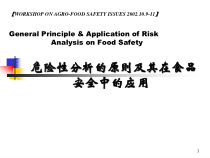 PPT
PPT
【文档说明】危险性分析的原则及其在食品安全中的应用.pptx,共(40)页,208.868 KB,由精品优选上传
转载请保留链接:https://www.ichengzhen.cn/view-289447.html
以下为本文档部分文字说明:
【WORKSHOPONAGRO-FOODSAFETYISSUES2002.10.9-11】GeneralPrinciple&ApplicationofRiskAnalysisonFoodSafety危险性分析的原则及其在食品安全中的应用1Fo
odsafety–aglobalconcern◼Foodingredientsandproductssourcedaroundtheworld◼食物原料和产品来源于世界各地◼Foodcontrolmeasuresnotthesameeverywhere◼各地的食品安全控制措施不
同◼Foodsafetymaybeperceiveddifferentlyindifferentpartsoftheworld◼不同地域对食品安全的认识不同◼Canobstructinternationalt
rade◼国际贸易受阻2CAC&WTO◼SPS和TBT协议是WTO成员在国际贸易中必须遵循的多边协定◼应用卫生与植物卫生措施协定,SPSSanitary/PhytosanitaryMeasuresAgreement◼贸易技术壁垒协议,TBTTheAgreement
onTechnicalBarrierstoTrade3WHO要求各会员国:◼在食品安全行动之下,重点制定和评估国家的控制战略,支持发展评估与食品相关风险的科学,包括分析与食源性疾病相关的高危因素;要最大可能利用发展中国家在食源
性因素危险性评估方面的信息以制定国际标准。4Riskanalysis–why?为什么要进行危险性分析◼Foodsafetyofincreasingconcern◼食品安全被广为关注◼Movetowardsariskbasedapproach◼趋向于对危
险性的研究◼Decisionmakingbasedonsoundscience◼基于科学基础上的决策5RiskAnalysis-whatisit?Aprocessconsistingof3components:◼riskasse
ssment危险性评估◼riskmanagement危险性管理◼riskcommunication危险性信息交流6RiskAnalysisParadigmRiskAssessmentRiskManagementRiskCommunication
SciencebasedPolicybasedInteractiveexchangeofinformationandopinions7RiskAssessment(CAC,1997)危险性评估◼Ascientificallybasedprocess◼科学
评估的程序◼Theevaluationofthepotentialforadverseeffectsonhumanoranimalhealtharisingfromthepresenceofadditives,contaminants,toxins
ordisease-causingorganismsinfood,beveragesorfeedstuffs.(WTO)◼评估食品、饮料、饲料中的添加剂、污染物、毒素或病原菌对人群或动物潜在副作用的科学程序。8RiskManagement(CAC,1997)危险性管理◼Thepr
ocess,distinctfromriskassessment,ofweighingpolicyalternatives,inconsultationwithallinterestedparties,consideringr
iskassessmentandotherfactorsrelevantforthehealthprotectionofconsumersandforthepromotionoffairtradepractices,a
nd,ifneeded,selectingappropriatepreventionandcontroloptions.◼在危险性评估的科学基础上,为保护消费者健康、促进国际食品贸易而采取的预防和控制措施。9RiskCommunication危险性信息交流◼Theinteractiveex
changeofinformationandopinionsthroughouttheriskanalysisprocessconcerninghazardsandrisks,riskrelatedfactorsandriskperceptions,amongri
skassessors,riskmanagers,consumers,industry,theacademiccommunityandotherinterestedparties,includingtheexplanationofriskassessmentfi
ndingsandthebasisofriskmanagementdecisions◼在危险性评估者,危险性管理者,消费者,企业,学术团体和其他组织间就危害、危险性,与危险性相关的因素和理解等进行广泛的信息和意见沟通,包括危险性
评估的结论和危险性管理决策。10危险性评估程序RiskAssessment危害的确定HazardIdentification危害的特征描述HazardCharacterization暴露量评估ExposureAssessment危险特征的描述RiskCharacterizat
ion11Hazard(CAC,1997)危害◼Abiological,chemicalorphysicalagentin,orconditionof,foodwiththepotentialtocauseanadversehealtheffect.◼食品中可能存在的影响人体健康的
生物、化学、物理因素,或状况。12HazardsinFood◼Microorganisms◼细菌◼Fungiandmycotoxins◼真菌和真菌毒素◼Virusesandparasites◼病毒和寄生虫◼Toxicplantsandanimals◼有毒动植物◼Po
tentialenvironmentaltoxicants◼潜在的环境有毒化学污染物13Hazardcharacterisation(CAC,1997)危害特征的描述◼Thequalitativeand/orquantitativeev
aluationofthenatureoftheadversehealtheffectsassociatedwiththehazard.ForthepurposeofMicrobiologicalRiskAssessmenttheconcer
nsrelatetomicroorganismsandtheirtoxins.◼微生物危害的定性(半定量)、定量评估14ExposureAssessment(CAC,1997)暴露评估◼Thequalitativeand/orquantitativeevaluationofthelikelyi
ntakeofbiological,chemicalandphysicalagentsviafoodaswellasexposuresfromothersourcesifrelevant.◼从食物或相关
来源摄入生物、化学和物理因子的定性、定量评估15RiskCharacterization(CAC,1997)危险性特征的描述◼Theprocessofdeterminingthequalitativeand/orquantitativeestimation
,includingattendantuncertainties,oftheprobabilityofoccurrenceandseverityofknownorpotentialadversehealtheffectsinagivenpopulationbasedonhazardi
dentification,hazardcharacterizationandexposureassessment.◼在危害的识别、危害的特征描述和暴露评估的基础上确定事件暴发的概率和严重性,或对健康产生潜在不良影响的定性和/定量评估的过程。16R
iskmanagement危险性管理4Elements:Riskevaluation危险性评价◼Riskmanagementoptionsassessment◼危险性管理选项评估◼Implementat
ion◼执行◼Monitoringandreview◼监测和回顾17Implementation执行◼Canbedonebybothgovernmentofficialsandthefoodindustry◼可被政府官方和食品企业
执行◼Implementationwilltakedifferentformsdependingwhatdecisionshavebeentaken◼执行将根据已定的决议采取不同形式◼MRAmaybeusefulinimplementation◼informat
iononproductpathogenpathway◼inparticularexposureassessmentcanbeavaluableinformationsource◼MRA在执行中的作用◼病原菌产生的途径◼特别是暴露评估可作为有价值的信息来源
18MonitoringandReview监测与评议◼Assesseffectivenessofmeasurestaken◼评估所用方法的效率◼providesmoredata◼提供更多数据◼providesinformation
needtoreviewriskmanagementdecisionandifneededriskassessment◼提供信息,以便评议危险性管理决议及是否需要危险性评估19RiskAnalysis-whousesit◼Atoolforuseprim
arilybygovernments各国政府◼protectconsumerhealth保护消费者健康◼maintainconfidenceininternationallytradedfood(marketma
intenance)-harmonization,mutualrecognition,equivalence维持在国际食品贸易中的信心-一体、共识、平等◼Atinternationallevel国际水平◼WTO-us
eriskassessmenttechniquesdevelopedbyrelevantinternationalorganizations国际贸易中采用由相关国际组织建立的危险性评估技术◼usedbystandardsettingbodies(Codex)被国际标准
指定团体所采用20CAC常遇到的问题◼Differentopinionsonmethodsoroutputsofassessment,eg.,using“Aslowasreasonablyachievable(ALARA)”
forcontaminants◼对专家评价方法或结果有不同看法,如污染物达到尽可能低的水平◼黄曲霉毒素(总量、B1、M1)◼Whenthereisscientificallyuncertainty◼当存在科学不确定性时◼食品中的单增李斯特菌(〈100cfu/g)◼氯丙醇
21◼JECFA,JointFAO/WHOExpertCommitteeonFoodAdditives◼FAO/WHO联合食品添加剂专家委员会◼JMPR,JointFAO/WHOMeetingonPesticideResidues◼FAO/WHO联
合农药残留专家委员会◼JEMRA,JointFAO/WHOExpertConsultationonMicrobiologicalRiskAssessment◼FAO/WHO联合微生物危险性评估专家咨询
委员会22FAO/WHO专家咨询组织与CAC有关委员会关系RelationshipbetweenexpertconsultationandCodexrelevantcommittees专家咨询(评估)制定标准(管理)ExpertconsultationStandardformulation(ass
essment)(management)JECFACCFACCCRVDFJMPRCCPRJEMRACCFH23FAO/WHOactivitiesonriskanalysisFAO/WHO召开的危险性分析专家咨询会议1995-ExpertConsultationonRiskAnalys
isandFoodSafety◼危险性分析与食品安全1997-ExpertConsultationonRiskManagementandFoodSafety◼危险性管理与食品安全1998-ExpertConsultationontheApplicationofRiskC
ommunicationtoFoodStandardsandSafetyMatters◼危险性信息交流在食品标准和安全中的应用241999-ExpertConsultationonRiskAssessmentofMicrobiologicalHazardsinFo
ods◼食品中微生物危害的危险性评估2000-ExpertConsultationonInteractionbetweenRiskassessorsandriskmanagersofMicrobiologicalHazardsinFood◼食品中微生物危害的危险性评估者与管理者间的
相互作用2001-ExpertConsultationonExposureAssessmentofMicrobiologicalHazardsinfoods◼食品中微生物危害的暴露评估2002-ExpertConsultationonIncorp
oratingQuantitativeRiskAssessmentintheDevelopmentofMicrobiologicalFoodHygieneStandards◼运用定量微生物危险性评估制订食品卫生标准25危险性评估(专家)添加剂—ADIRi
skAssessment污染物—PTWI兽药残留—ADI危险性管理(政府)添加剂—范围,用量RiskManagement污染物—限量危险性管理(政府)兽药残留—限量RiskManagementJECFACCFACRela
tionshipbetweenJECFAandCCFACorCCRVDCCRVD26CCFAC&JECFAExample:AflatoxinB1◼1994,CCFACaskedJECFA:(26thSession)toprovideestimatesofthetoxicologicalpotenc
yofaflatoxinsandtoderiveestimatesofthepotentialrisksfordifferentpopulations◼1996,JECFA(46thmeeting):Aflatoxinswereco
nsidered◼1997,JECFA(49thmeeting):Aflatoxinswerecarriedover27Quantitativeriskassessmentat49thJECFAMeet
ingin1997JECFA49次会议的定量危险性评价致癌作用强度:◼HBsAg(+):0.3个肝癌/年/10万人/ngAF/kgbw/天◼HBsAg(-):0.01个肝癌/年/10万人/ngAF/kgbw/天◼人群危险度=作用强度×摄入量28例1.HBsAg(+)1%;欧洲污染水平/欧洲
膳食结构摄入量人群危险度(ng/人/天)(个肝癌/年/10万人)限量20µg/kg190.0041(0.0006-0.01)限量10µg/kg180.0039(0.0006-0.01)相差2个肝癌/年/亿人29例2.HBsAg(+)25%;中国污染水
平/远东膳食结构摄入量人群危险度(ng/人/天)(个肝癌/年/10万人)限量20µg/kg1250.17(0.03-0.3)限量10µg/kg1030.14(0.02-0.3)相差300个肝癌/年/亿人*1990-92年全国肝癌死亡率20/10万30CCF
HACTIVITIES◼32ndCCFH(1999)DecidedtoproceedinMRAonthebasisofpathogen/commoditycombinations;Elaboratedandagreedontentativeprioritylistofpathogen
/commoditycombinations◼决定对病原食品组合进行微生物危险性评估,并提出暂定优先组合31CCFHDraftinggroups食品卫生法典委员会起草工作组◼L.monocytogenesinready-to-eatfood(Germany)◼即食食品中的单增李斯特
菌◼Salmonellaspp.inpoultry(Sweden)◼禽肉中的沙门氏菌◼Campylobacterspp.inpoultry(Netherlands)◼禽肉中的空肠弯曲菌◼Vibriospp.inseafood(UnitedSta
tes)◼海产品中的副溶血性弧菌◼EnterohemorrhagicE.coliinmeat(UnitedStates)◼肉食品中的出血性大肠杆菌32WhyRAisneededinChina?我国为什么要进行危险性分析?◼WTO◼CODEX/GB◼FOODINDUSTRY
◼◼FOODSAFETYCONTROL◼Government◼Consumers◼HEALTHPROTECTION◼Lifequality◼knowledge◼国际贸易◼食品法典/国家标准体系◼食品工业◼食品安全控制◼政府◼消费者◼保护消费者健康◼生活质量的提高◼对食品安全知识的需求
33CaseinChinaTheControloftheDeterioratedSugarcaneFoodPoisoning◼FreshsugarcanegrowninsouthernareaofChina◼◼Shipped,sto
redandsoldthroughthewinterseasoninthenorthernpartsofChina◼◼Contaminatedsugarcanecouldcausefatalfoodpoisoningwhensoldinthenextspring34Sugarcanepoisoni
ng◼ThefirstoutbreakofunknowncausessugarcanepoisoningoccurredinHenanProvincein1972◼From1972to1989:◼No.ofoutbreak:217◼No.ofcases:8
84◼No.ofdeaths:88◼Averagefatality:10%◼IdentifiedasaprioritytoassessandcontrolbyMOH35Etiologyandriskassessment◼Etio
logyandcausesstudywerebeencarriedoutbytheChineseAcademyofPreventiveMedicinein1980’s◼Arthriniumspp.wasthepathogenic
fungus;◼3-nitropropionicacid(3-NPA)producedbyA.spp.wasprovedtobethecausativecompound◼Assessmentwasmadeaccor
dingtocase-basedstudies,epidemiologicalandlaboratorystudies36Decisionmakingandmanagementactivities◼Basedondiscoveryandassessment,MOHpromul
gated:◼Diagnosticcriteriaandprinciplesforthemanagementofdeterioratedsugarcanepoisoning(WS/T10-1996);◼MethodsfortheisolationandidentificationofArthr
iniumstrainsandanalyzing3-nitropropionicacid(GB47689.16)◼MOHissuedanotificationonthepreventionandcontrolofDSPtoallprovincesofChina◼Anatio
nalhealthcampaignforpreventionandcontrolofthepoisoningwaslaunched37Goodresults◼Asaresultoftheseefforts
,sugarcanepoisoninghasbeensatisfactorycontrolled◼NotypicalcaseswerereportedinChinainthelast10years!38FAO/WHOActivates
inChina◼WorkshoponMicrobiologicalRiskAssessment◼SponsoredbyFAO/ILSI/WHO/MOH,May10-11,2002Beijing◼QuantitativeM
icrobiologicalRiskAssessmentTrainingCourse(DavidVose)◼SponsoredbyWHO/INFS,May13-24,2002Beijing◼NationalWorkshoponIntroductio
ntoRiskAnalysisintheFisheryIndustry◼SponsoredbyFAO/INFOYU,Aug12-23,2002Shanghai39Riskanalysis-concludingsummary◼Riskanalys
isanditscomponents◼Provideatoolformanagingrisks◼提供管理危险的工具◼Internationallyrecognizedapproach◼国际公认的手段◼Protectconsumerhealth◼保护消费者健康◼Foodprod
uctscouldbeacceptedbyinternationalmarket◼产品被国际市场所接受40
 辽公网安备 21102102000191号
辽公网安备 21102102000191号
 营业执照
营业执照